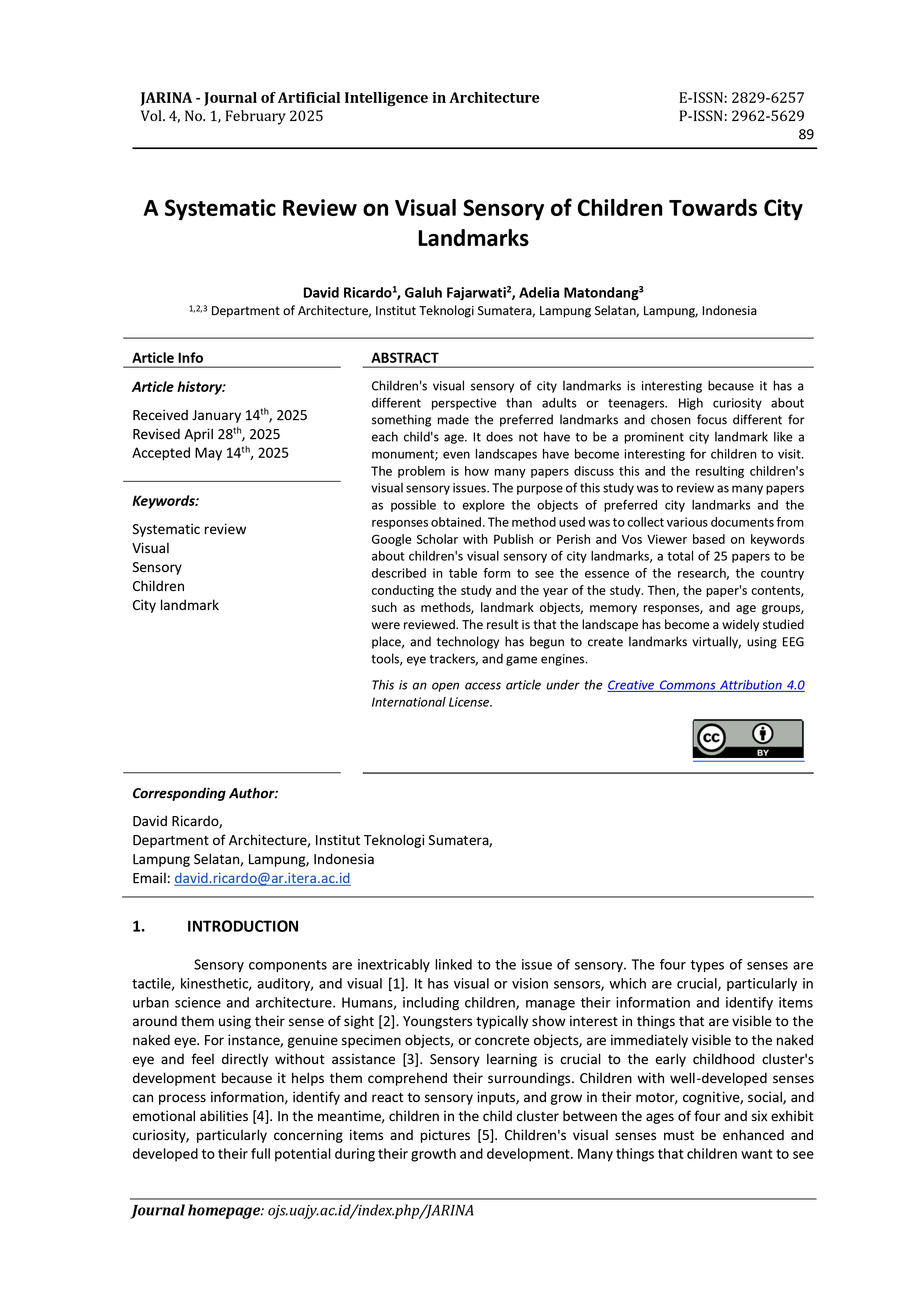A Systematic Review on Visual Sensory of Children Towards City Landmarks
DOI:
https://doi.org/10.24002/jarina.v4i2.10689Keywords:
Systematic review, Visual Sensory, Children, City landmarkAbstract
Children's visual sensory of city landmarks is interesting because it has a different perspective than adults or teenagers. High curiosity about something made the preferred landmarks and chosen focus different for each child's age. It does not have to be a prominent city landmark like a monument; even landscapes have become interesting for children to visit. The problem is how many papers discuss this and the resulting children's visual sensory issues. The purpose of this study was to review as many papers as possible to explore the objects of preferred city landmarks and the responses obtained. The method used was to collect various documents from Google Scholar with Publish or Perish and Vos Viewer based on keywords about children's visual sensory of city landmarks, a total of 25 papers to be described in table form to see the essence of the research, the country conducting the study and the year of the study. Then, the paper's contents, such as methods, landmark objects, memory responses, and age groups, were reviewed. The result is that the landscape has become a widely studied place, and technology has begun to create landmarks virtually, using EEG tools, eye trackers, and game engines.
References
[1] Raudhatul Jannah Assubaidi and Rudi Ritonga, “Peningkatan Kemampuan Membaca Permulaan Menggunakan Puzzle Pada Siswa Kelas I SD,” Mitra Pilar J. Pendidikan, Inovasi, dan Terap. Teknol., vol. 2, no. 2, pp. 105–112, 2023, doi: 10.58797/pilar.0202.08.
[2] Z. A. Fauzan, R. Himayani, N. Utami, and S. Rahmawati, “Fisiologi Pemrosesan Visual dan Faktor-faktor yang Memengaruhinya,” Med. Prof. J. Lampung, vol. 11, no. 1, p. 169, 2021.
[3] W. E. Larasati, D. Wahyuni, and M. Astuti, “Media Benda Nyata Specimen : Eksperimen Terhadap Stimulasi Sensori Anak,” Edukids J. Pertumbuhan, Perkembangan, dan Pendidik. Anak Usia Dini, vol. 21, no. 2, pp. 113–123, 2024, doi: 10.17509/edukids.v21i2.71701.
[4] A. Aslamiyah, S. Sulatri, and N. Khotimah, “Penggunaan Permainan Sains Colour March pada Sensori Anak Usia Dini,” J. Educ. Res., vol. 4, no. 2020, pp. 856–863, 2023, [Online]. Available: https://www.jer.or.id/index.php/jer/article/view/269%0Ahttps://www.jer.or.id/index.php/jer/article/download/269/203
[5] Albert Stefanus and Basana Nababan, “Media Audio Visual sebagai Alat Peraga pada Penyampaian Firman bagi Anak Usia 4-6 Tahun di Sekolah Minggu GKKK Bandung,” JUITAK J. Ilm. Teol. dan Pendidik. Kristen, vol. 2, no. 2, pp. 30–38, 2024, doi: 10.61404/juitak.v2i2.230.
[6] E. J. Marco, L. B. N. Hinkley, S. S. Hill, and S. S. Nagarajan, “Sensory processing in autism: A review of neurophysiologic findings,” Pediatr. Res., vol. 69, no. 5 PART 2, pp. 48–54, 2011, doi: 10.1203/PDR.0b013e3182130c54.
[7] P. Phylactou, A. Traikapi, M. Papadatou-Pastou, and N. Konstantinou, “Sensory recruitment in visual short-term memory: A systematic review and meta-analysis of sensory visual cortex interference using transcranial magnetic stimulation,” Psychon. Bull. Rev., vol. 29, no. 5, pp. 1594–1624, 2022, doi: 10.3758/s13423-022-02107-y.
[8] F. Permezel, J. Alty, I. H. Harding, and D. Thyagarajan, “Brain Networks Involved in Sensory Perception in Parkinson’s Disease: A Scoping Review,” Brain Sci., vol. 13, no. 11, 2023, doi: 10.3390/brainsci13111552.
[9] D. Cheng, C. Gao, T. Shao, and J. Iqbal, “A landscape study of sichuan university (Wangjiang campus) from the perspective of campus tourism,” Land, vol. 9, no. 12, pp. 1–21, 2020, doi: 10.3390/land9120499.
[10] X. Jin and J. Wang, “Assessing Linear Urban Landscape from dynamic visual perception based on urban morphology,” Front. Archit. Res., vol. 10, no. 1, pp. 202–219, 2021, doi: 10.1016/j.foar.2021.01.001.
[11] B. Bogdanovic, “Children’s perception of the visual identity of Belgrade,” Glas. Etnogr. instituta, vol. 70, no. 2, pp. 103–127, 2022, doi: 10.2298/gei2202103b.
[12] D. Yesiltepe, A. Ozbil Torun, A. Coutrot, M. Hornberger, H. Spiers, and R. Conroy Dalton, “Computer models of saliency alone fail to predict subjective visual attention to landmarks during observed navigation,” Spat. Cogn. Comput., vol. 21, no. 1, pp. 39–66, 2021, doi: 10.1080/13875868.2020.1830993.
[13] J. Keil, D. Edler, L. Kuchinke, and F. Dickmann, “Effects of visual map complexity on the attentional processing of landmarks,” PLoS One, vol. 15, no. 3, pp. 1–20, 2020, doi: 10.1371/journal.pone.0229575.
[14] Y. Zhao, J. Stefanucci, S. Creem-Regehr, and B. Bodenheimer, “Evaluating Augmented Reality Landmark Cues and Frame of Reference Displays with Virtual Reality,” IEEE Trans. Vis. Comput. Graph., vol. 29, no. 5, pp. 2710–2720, 2023, doi: 10.1109/TVCG.2023.3247078.
[15] S. Nugroho and J. Zhang, “Explorations of young people’s sense of place using urban design qualities in Surabaya, Indonesia,” 2022, mdpi.com. [Online]. Available: https://www.mdpi.com/2071-1050/14/1/472
[16] M. Moradi, A. A.- Yazdanfar, and S. N. Maleki, “Exploring the Sense of Place Components in Historic Districts: A Strategy for Urban Designers and Architects,” Int. J. Archit. Eng. Urban Plan, vol. 30, no. 1, pp. 30–43, 2020, doi: 10.22068/ijaup.30.1.30.
[17] J. L. Walter, L. Essmann, S. U. König, and P. König, Finding landmarks–An investigation of viewing behavior during spatial navigation in VR using a graph-theoretical analysis approach, vol. 18, no. 6. 2022. doi: 10.1371/journal.pcbi.1009485.
[18] R. Ma, Y. Luo, and K. Furuya, “Gender differences and optimizing women’s experiences: An exploratory study of visual behavior while viewing urban park landscapes in tokyo, japan,” 2023, mdpi.com. [Online]. Available: https://www.mdpi.com/2071-1050/15/5/3957
[19] L.- Maggi et al., “UC Santa Barbara GIScience 2021 Short Paper Proceedings Title Improving pedestrians’ spatial learning during landmark-based navigation with auditory emotional cues and narrative Permalink https://escholarship.org/uc/item/89h883x4 Publication Date Improvin,” 2021, doi: 10.25436/E26P43.
[20] M. J. Starrett et al., “Landmarks: A solution for spatial navigation and memory experiments in virtual reality,” Behav. Res. Methods, vol. 53, no. 3, pp. 1046–1059, 2021, doi: 10.3758/s13428-020-01481-6.
[21] A. Bredmose, S. Grangaard, V. L. Lygum, and ..., “Mapping the importance of specific physical elements in urban space for blind and visually impaired people,” J. Urban …, 2023, doi: 10.1080/13574809.2022.2097862.
[22] G. Filomena and J. A. Verstegen, “Modelling the effect of landmarks on pedestrian dynamics in urban environments,” Comput. Environ. Urban Syst., vol. 86, no. October 2020, p. 101573, 2021, doi: 10.1016/j.compenvurbsys.2020.101573.
[23] R. Askarizad and J. He, “Perception of Spatial Legibility and Its Association with Human Mobility Patterns: An Empirical Assessment of the Historical Districts in Rasht, Iran,” Int. J. Environ. Res. Public Health, vol. 19, no. 22, 2022, doi: 10.3390/ijerph192215258.
[24] A. Zajadacz and A. Lubarska, “Sensory gardens as places for outdoor recreation adapted to the needs of people with visual impairments,” 2020, bibliotekanauki.pl. [Online]. Available: https://bibliotekanauki.pl/articles/1391129.pdf
[25] Y. Huang and B. Zheng, “Social Media Users’ Visual and Emotional Preferences of Internet-Famous Sites in Urban Riverfront Public Spaces: A Case Study in Changsha, China,” Land, 2024, [Online]. Available: https://www.mdpi.com/2073-445X/13/7/930
[26] M. Liu and S. Nijhuis, “Talking about landscape spaces. Towards a spatial-visual landscape design vocabulary,” Des. J., vol. 25, no. 2, pp. 263–281, 2022, doi: 10.1080/14606925.2021.2021672.
[27] B. Cheng, A. Wunderlich, K. Gramann, E. Lin, and S. I. Fabrikant, “The effect of landmark visualization in mobile maps on brain activity during navigation: A virtual reality study,” Front. Virtual Real., vol. 3, no. November, pp. 1–18, 2022, doi: 10.3389/frvir.2022.981625.
[28] M. He, Y. Wang, W. J. Wang, and Z. Xie, “Therapeutic plant landscape design of urban forest parks based on the Five Senses Theory: A case study of Stanley Park in Canada,” Int. J. Geoheritage Park., vol. 10, no. 1, pp. 97–112, 2022, doi: 10.1016/j.ijgeop.2022.02.004.
[29] J. D. Rounds, J. G. Cruz-Garza, and S. Kalantari, “Using Posterior EEG Theta Band to Assess the Effects of Architectural Designs on Landmark Recognition in an Urban Setting,” Front. Hum. Neurosci., vol. 14, no. December, pp. 1–15, 2020, doi: 10.3389/fnhum.2020.584385.
[30] J. Liu, A. K. Singh, and C. T. Lin, “Using virtual global landmark to improve incidental spatial learning,” Sci. Rep., vol. 12, no. 1, pp. 1–14, 2022, doi: 10.1038/s41598-022-10855-z.
[31] E. M. Barhorst-Cates, J. Stoker, J. K. Stefanucci, and ..., “Using virtual reality to assess dynamic self-motion and landmark cues for spatial updating in children and adults,” 2021, Springer. doi: 10.3758/s13421-020-01111-8.
[32] C. Basdekidou, “Visual Contribution to Motor Skill DCD Disorders & Walking Physiology Using Spatial Cognition and Linear Geometries as Landmark Coordination Cues,” Ophthalmol. Res. An Int. J., vol. 18, no. 1, pp. 10–37, 2023, doi: 10.9734/or/2023/v18i1375.
[33] D. K. Hassan and A. Elkhateeb, “Walking experience: Exploring the trilateral interrelation of walkability, temporal perception, and urban ambiance,” 2021, Elsevier. [Online]. Available: https://www.sciencedirect.com/science/article/pii/S209526352100011X

Downloads
Published
How to Cite
Issue
Section
License
Copyright (c) 2025 David Ricardo, Galuh Fajarwati, Adelia Matondang

This work is licensed under a Creative Commons Attribution 4.0 International License.
Authors who publish with this journal agree to the following terms:
1.Authors retain copyright and grant the journal right of first publication with the work simultaneously licensed under a Creative Commons that allows others to share the work with an acknowledgement of the work's authorship and initial publication in this journal.
2.Authors are able to enter into separate, additional contractual arrangements for the non-exclusive distribution of the journal's published version of the work (e.g., post it to an institutional repository or publish it in a book), with an acknowledgement of its initial publication in this journal.
3.Authors are permitted and encouraged to post their work online (e.g., in institutional repositories or on their website) prior to and during the submission process, as it can lead to productive exchanges, as well as earlier and greater citation of published work (See The Effect of Open Access).
















